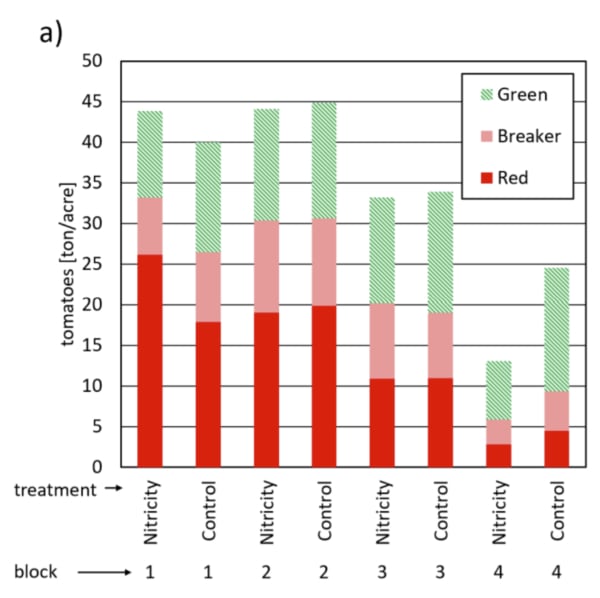June 17, 2025 | 17:42 GMT +7
June 17, 2025 | 17:42 GMT +7
Hotline: 0913.378.918
June 17, 2025 | 17:42 GMT +7
Hotline: 0913.378.918
Their onsite fertilizer production eliminates emissions from transporting fertilizers, and provides a viable alternative to fossil consuming nitrogen fixation methods like the Haber-Bosch process.
Nitricity is using solar electricity to extract nitrogen directly from our air to produce nitric acid, the most critical nutrient in fertilizer that plants use to grow everything we humans eat. The key features of the company’s product are the decarbonization, decentralization, and privatization of fertilizer manufacturing, made possible by affordable, off-grid, intermittent solar electricity.

Process
The company installed its first commercial project in October of 2021. The off-grid solar power system is composed of 144 solar panels, though details describing the solar hardware were scant.
On their website, Nitricity shares an experimental report on their pilot project in Fresno, California. The initial installation’s solar system was a 16-panel ground-mount array that outputted 75-85 V with a maximum power of 2.4 kW.
The installation was coupled directly with a sub-surface irrigation system used to fertigate a tomato crop. The paper covers the apparent success of their hardware, which produced tomatoes in a volume and quality that were similar to the control tomatoes. (The control tomatoes received a standard, industrially produced nitrogen fertilizer.)
Pilot project
Nitricty believes that their product will fill several niches. Because the system is easily distributed, farmers located far from fertilizer manufacturing centers will have additional financial incentive to try out the new technology.
Nitricity’s process directly competes with industrial ammonia production – a process which directly creates more CO2 than any other human driven chemical process on earth. The primary feedstock for modern nitrogen fixation is natural gas. The processing of the gas into ammonia releases these emissions. The chemical process emissions are only part of the story, as the emissions released from the fossil fuels traditionally used to heat and sustain the reaction are also excessive.
In its favor, the Haber-Bosch process was largely responsible for the Green Revolution of the middle 1900s, which helped catapult the global population. It is estimated that nearly half of all nitrogen currently found in human tissue was produced using this process.
Additionally, Niticity’s distributed, localized nitrogen solution also avoids transportation emissions. The company points out that market inefficiencies related to the distribution process of fossil-sourced nitrogen fertilizers can increase a farmer’s fertilizer cost as much as two to five times above the costs at a factory. Fossil-based fertilizer production costs are also volatile due to their direct relationship with natural gas – which, as mentioned earlier, supplies the primary feedstock for industrial ammonia.

Project results
In December, the US Department of Energy’s ARPA Energy awarded the group $500,000 to advance their “non-thermal plasma reactor” process. ARPA notes that, “literature and modeling analysis suggest that an energy efficiency ten times better than present plasma values and equal to or better than that of the conventional Haber-Bosch process could be achieved”.
In an interview with Agrifood Conversations, the company noted that the intermittent nature of solar power is not only easily managed, but is actually a desired trait. According to one of Nitricity’s founders, Nicolas Pinkowski, the process “operates better intermittently. Because we manufacture nitrates (NO3-), there is a lot of oxygen to transport per lb of nitrogen”. Nitricity uses a 200 gallon tank to store the product prior to it being applied to the tomatoes.
In August of 2021, the company raised $5 million. Recently, Nitricity announced that it signed a deal with a wheat producer by releasing some emissions-focused math:
1 acre of wheat needs about 100 lbs of nitrogen.
100 lbs of N (via ammonia or urea) are produced in a coal- or NG-fired factory today, emitting ~300 lbs CO2.
~1.5 lbs of N2O are emitted per acre via the nitrification process. This means one acre emits approximately 450 lbs CO2 due to soil N2O emissions.
In total, 1 acre of wheat can emit as much as 750 lbs CO2 emissions from fertilizer production and application.
Nitricity’s technology mitigates nearly 100% of these emissions.
It could be that these fertilization systems will integrate with solar powered greenhouses and other responsible land management techniques. In doing so, solar power will likely prove to be indispensable to our future food production.
(magazine)

(VAN) Extensive licensing requirements raise concerns about intellectual property theft.

(VAN) As of Friday, a salmonella outbreak linked to a California egg producer had sickened at least 79 people. Of the infected people, 21 hospitalizations were reported, U.S. health officials said.

(VAN) With the war ongoing, many Ukrainian farmers and rural farming families face limited access to their land due to mines and lack the financial resources to purchase needed agricultural inputs.

(VAN) Vikas Rambal has quietly built a $5 billion business empire in manufacturing, property and solar, and catapulted onto the Rich List.

(VAN) Available cropland now at less than five percent, according to latest geospatial assessment from FAO and UNOSAT.

(VAN) Alt Carbon has raised $12 million in a seed round as it plans to scale its carbon dioxide removal work in the South Asian nation.

(VAN) Attempts to bring down the price of the Japanese staple have had little effect amid a cost-of-living crisis.